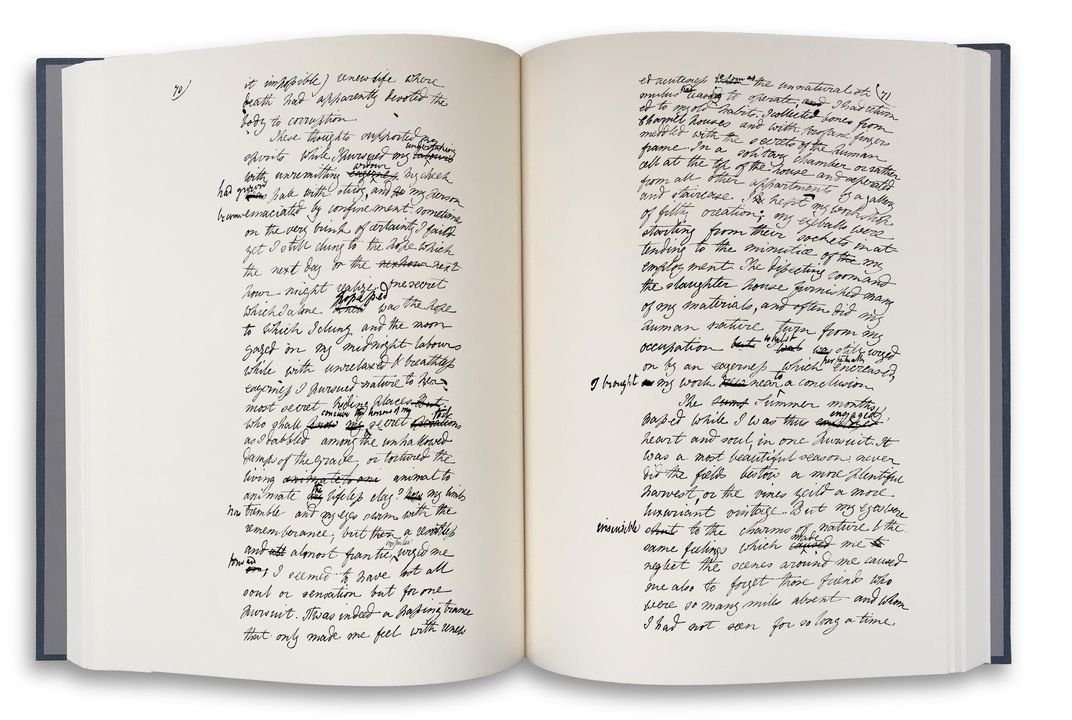Mary Shelley, as the famous story goes, first conceived of Frankenstein on a stormy night in 1816, while vacationing at the Lake Geneva villa of Lord Byron. The poet challenged his guests to “each write a ghost story,” as Shelley later explained in the introduction to her iconic novel, and she would spend the following months scribbling her tale of the “Modern Prometheus” and his monster into two large notebooks.
In honor of the 200th anniversary of Frankenstein’s publication, the British publisher SP Books is releasing a facsimile of Shelley’s original manuscript. According to Roslyn Sulcas of the New York Times, the limited run will produce 1,000 copies of the facsimile, which will be available for purchase starting March 15.
Most copies of Frankenstein derive from an 1831 edition that was heavily revised, reports Alison Flood of the Guardian. SP Book’s facsimiles are based on Shelley’s original notebooks, which are held today by Oxford’s Bodleian Library. These manuscripts offer unique insight into how Shelley’s novel evolved as she revised the text. The facsimile shows, for instance, that the author softened her portrayal of Frankenstein’s monster. In one sentence, she scratches out the word “creature” and replaces it with "being." In another, the "fangs" that Victor imagines gripping his neck become "fingers."
The facsimiles also preserve notes made by Percy Shelley, Mary’s husband and a prominent Romantic poet. He suggests, for example, that Mary add "lustrous black" to her description of the monster’s hair. In one passage, he corrects her spelling of “enigmatic, which Mary had written as "igmattic." "[E]nigmatic o you pretty Pecksie!" Percy chastises Shelley teasingly. (According to Graham Henderson, who runs a blog focusing on Shelley and the Romantics, Shelley "was prone to double the letter 'm' while her husband had an ie/ei problem with words like 'viel' and 'thier.'")
Jessica Nelson, a founder of SP Books, tells Flood that the notations reveals another layer of the manuscript. “What’s really moving about this manuscript," she says, "is that you can see the literary work mixed with something tender and emotional–literature and love inside the pages of the manuscript. Their two handwritings are very similar, which is bizarre and sweet at the same time."
Shelley was just 18 years old when she wrote Frankenstein, and in her introduction to the 1831 edition, she writes that many people had asked her “how a young girl, came to think of, and to dilate upon, so very hideous an idea?” Shelley, downplaying her work, chalked it up to “imagination, unbidden, possessed,” but the facsimiles show that thoughtful writing and meticulous revisions played an important role in creating one of the most enduring horror stories of all time.

saiph on March 2nd, 2018 at 13:13 UTC »
If you can't afford to drop $250 on the facsimiles, you can still look through the Frankenstein digital manuscripts at the Shelley Goodwin Archive. Definitely worth flipping through!
vtschoir on March 2nd, 2018 at 10:45 UTC »
I picked up a copy of the book (not this version) for the first time the other day, and upon reading the introduction, positively fell in love with Mary's way with words. Like "holy shit, I would have swooned to meet someone who writes in this way"
Now, I realize she was 18... and that makes me the monster.
monol0g on March 2nd, 2018 at 10:17 UTC »
I hope someone releases a 1:1 copy of this. Like amazon did back in the day with the handwritten JK Rowling book